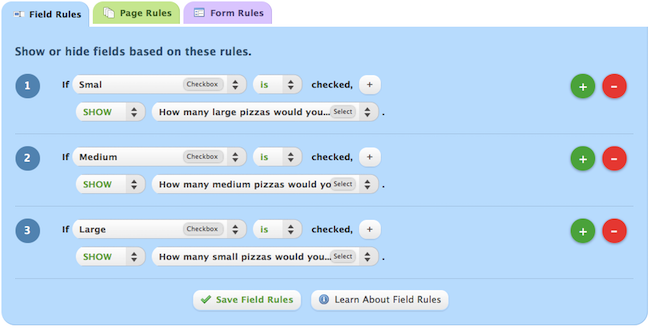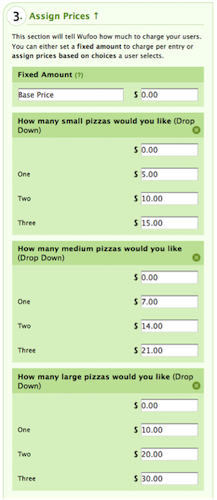
Want your customers to order multiple amounts of a product, do you? You won’t be able to take a selection and multiply it by a quantity to come up with a total amount owed, so you have to be a bit clever with how you set everything up.
Well, we love to be clever at Wufoo and we’re here to help you be even more–wait for it–clever too. On the face of it, the solution to quantity pricing is reasonably straight forward. You can add a dropdown menu to your form and have the user pick the quantity from the dropdown. Assign different prices to each quantity and Bob’s your father’s brother, you’re done. When you have multiple products with different prices though, things can start to get weird.
So we love pizza (who doesn’t??), so we’ve created an order form for everyone to order their pizza. However, different sizes mean different prices so we can’t apply the same price to every pizza. If we want to order 5 large pizzas and 5 mediums, the prices of those pies must be different.
The first thing we have to do is create a checkbox field which asks the user exactly what they want. Using a checkbox field will allow them to select more than one option, which they may want to do. Once that’s done, we can create a dropdown field for each product that you have. In our case we have three different sizes, so we’ve created three different dropdowns. Those fields will ask the user how much of that product they want.
Check it out:

That all looks very lovely, but if someone doesn’t want a medium pizza, they probably don’t want to see a dropdown that asks how many medium pizzas they would like. To neaten everything up a bit, we can use field rules to only show the fields that correlate to the selection in the checkbox field. If someone only chooses the “Small” option, we only want them to see the dropdown for small pizzas. Those are easy rules to setup.
In our example, they’ll look like this:

Almost there. All that needs to be done is setting the prices to those dropdown fields. When you head over to your payment settings you’ll be able to assign different prices to each field option in your form. Just assign the relevant prices to each field option and you’ll be good to go.

Now our users can pick exactly what pizza size they’d like and also pick how many of each size they’d like. That will come up with a total price that makes sense. You can check out that form here if you want to give it a try or if you just want to dream of the next pizza you’ll eat. This method should outside of a pizza order form as well, so give it a go on your own form!
Questions for our man, Kane? Let him know in the Comments section below. As always, don’t forget about our splendiferous (yep, that’s right) and spiffy Guides page for even more tips and best practice posts.

Comments
Did you also use a report for the results of this form? Creating a longer request form (six items with related fields) and am finding that the report returns all six on one long row.
Also, does it relate back to master order information, like name, address, phone #?
Posted June 16th, 2015 by jb.Everyone needs a hug.
Posted June 16th, 2015 by Karla Byron.I have a form with several different events and once i chose one item and add another it deletes out the first chioice, I need to be able to purchase several items and then get a total?
if I wanted to set up a form allowing child registration by age – lets say grouped like this:
Posted June 16th, 2015 by kristen jordan.0-18 mos
18 mos – 3 years
4-6 yrs
7-10 years
and I want to know how many children in each age group they want to register (which would trigger the cost per child) – I know how to do that – where I get tripped up is setting a maximum. Some families have two children in the same age group which makes it difficult to set maximums and I can only have 12 children per age group.